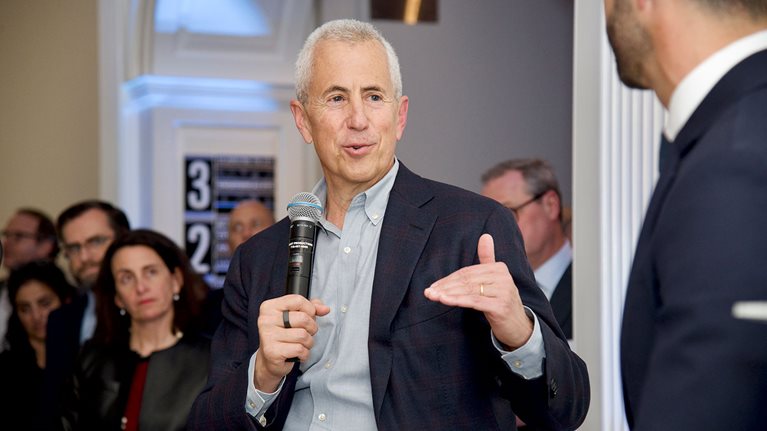The Museum of the City of New York chronicles the vast history of struggles, victories, and opportunities that have made the city what it is. Now, as it confronts a post-pandemic future, the city again arrives at a historic crossroads.
To meet this moment, McKinsey recently held the Future of New York Summit at the museum. The city is home to McKinsey’s largest office, with over 3,000 colleagues. It’s also one of our oldest; the office celebrated its 90th anniversary in 2022.
Business, nonprofit, and government leaders gathered to hear our latest research on catalyzing inclusive economic growth. Speakers from the mayor’s office, restaurateur Danny Meyer, actor and director Lin-Manuel Miranda, former US Treasury Secretary Lawrence H. Summers, and other luminaries informed and inspired attendees, calling on them to take action to address the needs of the city identified in a new McKinsey report, New York Metro Area workforce: Challenges and opportunities for growth. It looks at factors that are keeping residents out of the labor force and impeding workers from coming to the city—and what leaders can do to build a stronger future for every New Yorker.
Sheena Wright, First Deputy Mayor to Mayor Eric Adams, urged the crowd not to simply recover from the pandemic, but to achieve a city never seen before. “My charge to you, as shared caretakers of the future of this city, we can reimagine and create what it could and should be,” she said. “If we center the lived experiences of our people in all we do, we will realize our vision.”
The report chronicles how the strength of the city has long been its people. The region has the highest GDP per worker of any city in the nation. It has the most people holding bachelor’s and advanced professional degrees, and the largest share of immigrants participating in the labor force relative to population.
Yet there are significant challenges—brewing even before the pandemic—that are holding the city’s economy back.
According to our research, the educational attainment of unemployed New Yorkers does not match the needs of employers: 51 percent want to hire those with a bachelor’s degree or higher when only 33 percent have such degrees.

This mismatch contributes to New York having the lowest labor force participation rate among other major US cities. Furthermore, automation will hit workers without bachelor’s degrees hardest. In the top seven occupations projected to be impacted by automation, 47 percent of workers are Black or Hispanic.
Lawrence H. Summers stressed that early investment in the city’s youth is key to solving these issues. “Long-term business success depends on the success of our urban public schools and achieving close to universal inclusion,” he said.
Maria Torres-Springer, Deputy Mayor for Economic & Workforce Development, discussed how challenges in affordable housing constrain the city’s economic development. McKinsey’s research shows that over the last decade, median rent has risen 29 percent, but wages have risen only 23 percent; employment has risen 12 percent, but housing stock only 4 percent.
“New York City is the purest distillation of the promise of this country, but a decent and safe home is out of reach,” she said. Our research found that international migration to the city has decreased 37 percent in the last decade, and domestic migration by 16 percent.
While many speakers referred to these challenges as sobering, there was also much excitement over progress made and opportunities ahead.
Danny Meyer discussed the many long-term changes to the restaurant industry brought about by the extreme disruption of the pandemic, such as reforming wage practices to increase racial equity and increasing revenue through outdoor dinning.
“We accelerated our diversity goals by five years because of the pandemic,” said Danny. “The shutdown was devastating, but we were able to take the boat out of the water and inspect the barnacles. When else would we have had the opportunity?”
Lin-Manuel Miranda, in a fireside chat with CBS News’ Gayle King, discussed how his family immigrated to New York City from Puerto Rico. He told the crowd he wrote “Wait for it,” an iconic song from his show Hamilton, while riding the subway, and that the city must always be a place that welcomes immigrants and offers opportunities like he’s had.
A core belief at McKinsey is that economies are stronger when growth opportunities are created for everyone—this served as our inspiration for the Future of New York Summit. Our hope for the summit was that it could serve as a catalyst for change.
“What’s inspiring about the subway is you see the unique diversity of our city, the McKinsey person next to the Mariachi band,” he said. “And you can feel how both of them, everyone, make every other city feel like summer camp.”
Yael Taqqu, managing partner for McKinsey’s New York Office, who hosted the evening, commented: “A core belief at McKinsey is that economies are stronger when growth opportunities are created for everyone—this served as our inspiration for the Future of New York Summit. Our hope for the summit was that it could serve as a catalyst for change. I believe that as a group, the institutions and people that attended have all we need to solve these problems.”